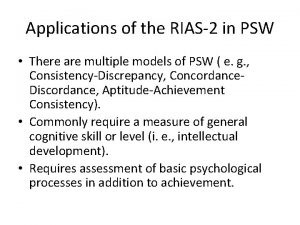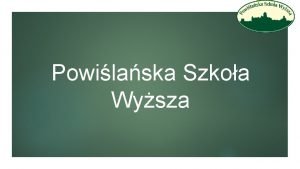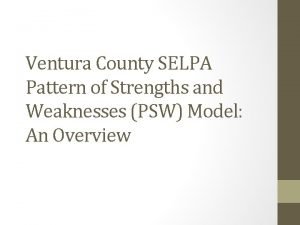Applications of the RIAS2 in PSW There are





- Slides: 5

Applications of the RIAS-2 in PSW • There are multiple models of PSW ( e. g. , Consistency-Discrepancy, Concordance. Discordance, Aptitude-Achievement Consistency). • Commonly require a measure of general cognitive skill or level (i. e. , intellectual development). • Requires assessment of basic psychological processes in addition to achievement.

What is “Pattern of Strengths and Weaknesses? ” A Quick Overview Actual cognitive area of weakness is significantly lower than expected based on overall cognitive ability. Cognitive deficit(s) is specific, not general or pervasive, because overall cognitive ability is at least average. Cognitive Strengths Average or better overall ability, aka, g Supported by strengths in academic skills Cognitive Weakness/Deficit Cognitive Ability or Processing Disorder Actual academic area of weakness is significantly lower than expected based on overall cognitive ability. Academic deficit(s) is unexpected because overall cognitive ability is at least average (and other factors were ruled out, such as inadequate instruction). Academic Weakness/Failure Performance approximately 1 SD below the mean or lower (cognitive and academic areas of weakness are related empirically and relationship is ecologically valid). Academic Skills/Knowledge Deficits Modified/adapted from: Sotelo, Flanagan, and Alfonso (2011). Overview of SLD Identification. In D. P. Flanagan & V. C. Alfonso, Essentials of Specific Learning Disability Identification. Hoboken, NJ: Wiley; Flanagan, Fiorello, and Ortiz (2010); Hale, Flanagan, and Naglieri (2008)

Common Psychological Processes in PSW Models

RIAS-2 Is a Strong, Efficient Fit to PSW Models • RIAS-2 provides the least confounded (read purest) measurement of intellectual development (i. e. , g) for the largest number of students you will encounter (hence we believe it should be the intelligence test of choice in PSW models). • RIAS-2 emphasizes problem-solving in the assessment of intelligence. Problem-solving is a key psychological process in most PSW models as well and the RIAS-2 has both verbal and nonverbal (crystallized and fluid) problem-solving Indexes—the VIX and the NIX. • RIAS-2 provides you with a co-normed assessment of verbal and nonverbal memory processes. • RIAS-2 provides co-normed verbal and nonverbal processing speed tasks which are greatly motor-reduced, providing assessment of mental control, attention, and simple processing speed. • Nothing goes to waste when applying the RIAS-2 in PSW models. • All data are collected quickly and in formats most children and adolescents find engaging and fast moving, enhancing rapport and cooperation.

RIAS-2 and Achievement in PSW • RIAS-2 Manual provides predicted achievement scores for all 9 of the AAB indexes based on any RIAS-2 Index. • Allows direct confident and accurate comparisons of any RIAS-2 Index with these obtained achievement scores. • You can compare predicted AAB scores to obtained achievement scores on the AAB with great confidence and accuracy. • RIAS-2 correlates as well or better with achievement tests generally compared to other intelligence measures.









